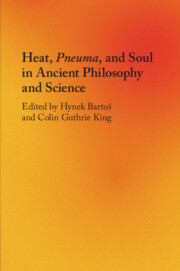Book contents
- Heat, Pneuma, and Soul in Ancient Philosophy and Science
- Heat, Pneuma, and Soul in Ancient Philosophy and Science
- Copyright page
- Contents
- Contributors
- Preface
- Introduction
- I Early Greek Philosophy and Medicine
- II Aristotle
- Chapter 7 Heat, Meteorology, and Spontaneous Generation
- Chapter 8 Aristotle on the Nature in the Pneuma and the First Body
- Chapter 9 Aristotle on the Powers of Thermic Equilibrium
- Chapter 10 Why Animals Must Keep Their Cool: Aristotle on the Need for Respiration (and Other Forms of Cooling)
- Chapter 11 Soul’s Tools
- Chapter 12 When Life Imitates Art: Vital Locomotion and Aristotle’s Craft Analogy
- Chapter 13 Blood, Pneuma, or Something More Solid? Aristotle on the Material Structure of Perceptual Apparatus
- Chapter 14 The Pathological Role of Pneuma in Aristotle
- Bibliography
- Index Locorum
- Index
Chapter 13 - Blood, Pneuma, or Something More Solid? Aristotle on the Material Structure of Perceptual Apparatus
from II - Aristotle
Published online by Cambridge University Press: 20 February 2020
- Heat, Pneuma, and Soul in Ancient Philosophy and Science
- Heat, Pneuma, and Soul in Ancient Philosophy and Science
- Copyright page
- Contents
- Contributors
- Preface
- Introduction
- I Early Greek Philosophy and Medicine
- II Aristotle
- Chapter 7 Heat, Meteorology, and Spontaneous Generation
- Chapter 8 Aristotle on the Nature in the Pneuma and the First Body
- Chapter 9 Aristotle on the Powers of Thermic Equilibrium
- Chapter 10 Why Animals Must Keep Their Cool: Aristotle on the Need for Respiration (and Other Forms of Cooling)
- Chapter 11 Soul’s Tools
- Chapter 12 When Life Imitates Art: Vital Locomotion and Aristotle’s Craft Analogy
- Chapter 13 Blood, Pneuma, or Something More Solid? Aristotle on the Material Structure of Perceptual Apparatus
- Chapter 14 The Pathological Role of Pneuma in Aristotle
- Bibliography
- Index Locorum
- Index
Summary
Roreitner scrutinizes Aristotle’s physiological description of perceptual processes, for which two alternative interpretations have been advocated in the past: it is either pneuma or blood which secures the communication between the peripheral organs of distal senses and the central organ. Roreitner assesses both these traditional interpretations and provides a third alternative according to which it is the body of blood-vessels rather than their content which provides this communication.
- Type
- Chapter
- Information
- Heat, Pneuma, and Soul in Ancient Philosophy and Science , pp. 288 - 309Publisher: Cambridge University PressPrint publication year: 2020

